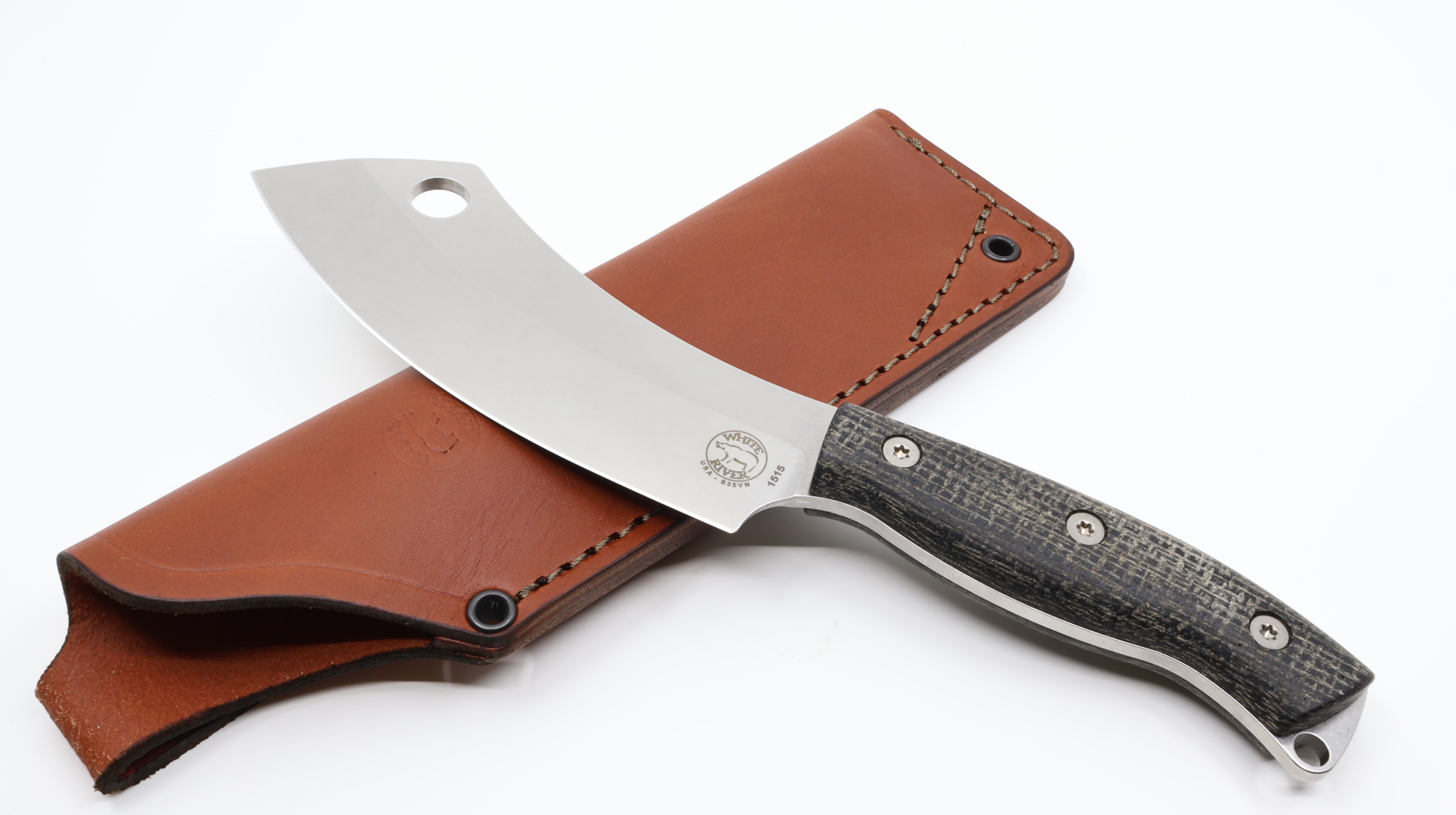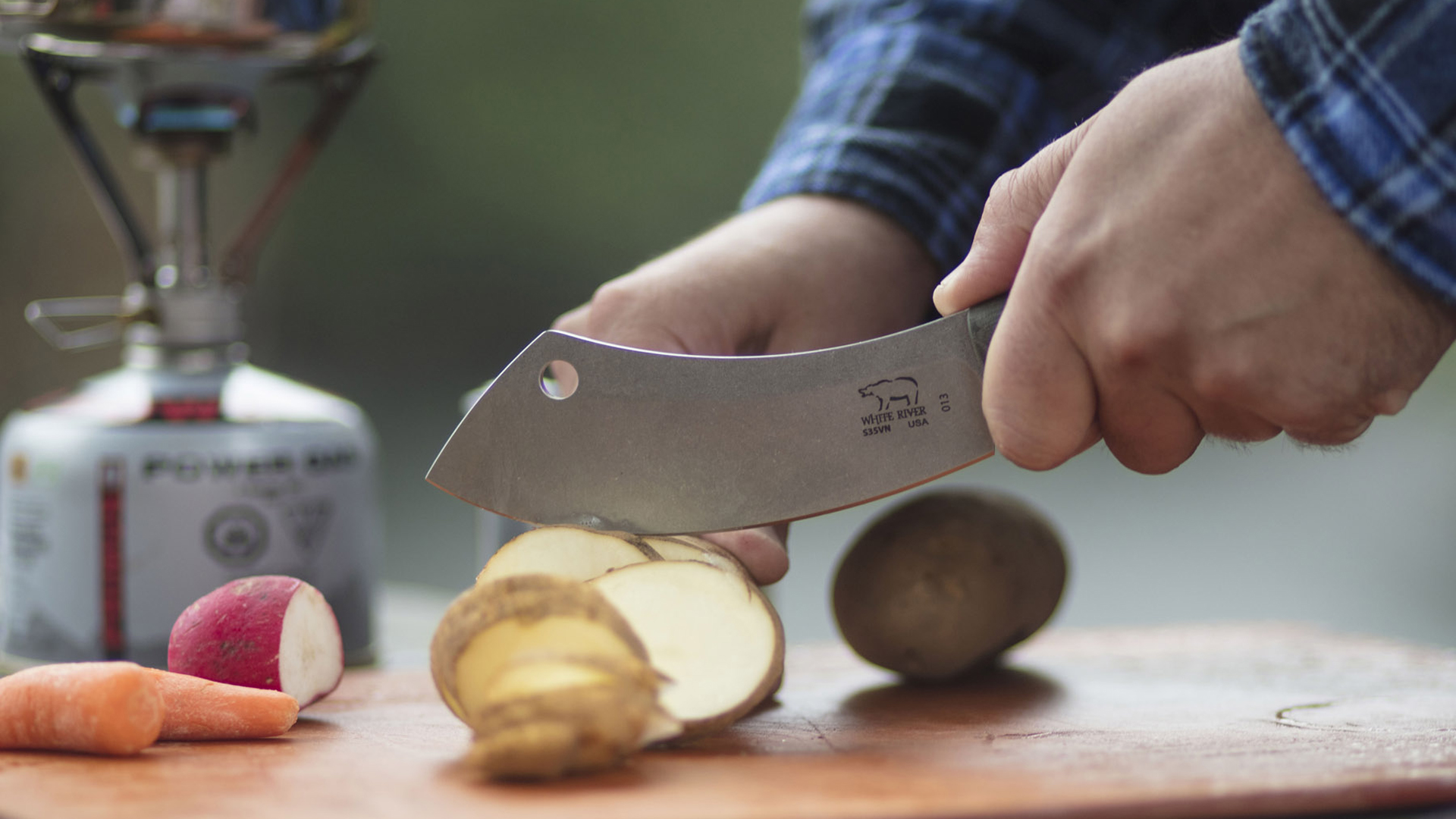
I never really felt a Cleaver could make a good outdoor knife, seems like it would be more suited for the camp kitchen or when butchering. So then why did I buy a White River Camp Cleaver? Simply because I felt like trying something different, does a knife fanatic need any other reason? Let's start with some specs...
* Blade Length: 5.5"
* Handle Length: 4.75"
* Overall Length: 10.25"
* Steel: CPM S35VN
* Blade Thickness: .158"
* Hardness: HRC 58-60
* Handle Material: Richlite
* Weight: 9.3 oz.
* Sheath: Leather pouch
* Price: $255
The day I headed for the woods was gorgeous and in my haste to get dirty I inadvertently left my phone in the truck. That means no usage pictures this time folks, just stock images from White Rivers website.
Out of the box the edge was very sharp, for anyone who's bought a White River knife before you probably aren't shocked. Despite quite a bit of use it stayed that way for the entire day. I stropped it when I got home but I'm not sure it even needed to be. I was out for about 10 hours and during that time I carved 2 try sticks, battoned quite a bit of wood, cut notches into poles and cross pieces to build a ladder and used it to remove the nubs off several branches I had hacked from trees. That last part is noteworthy; given this is not a large or heavy knife I didn't expect much when deburring, but the Camp Cleaver seemed unfazed. I suspect the edge sharpness and blade profile helped with that. Speaking of the profile...
The White River Camp Cleaver worked better for carving then I thought it might. The continuously rounded edge seamlessly cut into wood, somewhat surprising given its high saber grind. Creating try sticks was easy, the blade shape made push cuts with my thumb very comfortable. The spine is not sharp so there was no irritation. For me that's both a good thing and a bad thing; I prefer a sharpened spine, so while it did make wood carving less painful I would still prefer it not have the edges smoothed. Overall the knife feels balanced in the hand, the center point is pretty much where the front of the scales meet the blade.
Although the handle is a good length - at 4.75" - it's a touch thin and narrow for those of us who wear XL gloves. The shape is good, and fits your hand correctly in all the right places, but it could be thicker. When I was applying a lot of pressure the knife would twist, that lack of ultimate control can get a bit unnerving. The outer edges of the handle are gently rounded so there were no hot spots. Unfortunately the tang extends beyond the scales. While the difference between the materials is subtle it was still noticeable to me, especially when the knife would torque when applying pressure with sweaty palms. Some call that style of tang-to-scale integration "proud", but to my eye and hand it presents an unfinished appearance and feel. I know it was a deliberate design for White River, but in my opinion it would be better to follow the more traditional method and have the tang/scale integration be seamless.
I chose Richlite for the handle material. As of this writing it doesn't appear to be available any longer though, that's a shame because it works very well. Richlite is made from recycled paper that's layered with phenolic resin, that compound is then heated and compressed. Because of the compressing process Richlite has a high-density so it resists absorbing things like oils, blood, perspiration and dirt. It's also purported to have excellent durability. There's a natural texture to Richlite, between that finish and the material itself hand grip was excellent (when I wasn't working it too hard, of course). Unlike Micarta, Richlite isn't susceptible to staining. Because of that, it's also antimicrobial enough to do food prep. G10 is my preferred handle material for many of the same reasons, since Richlite has similar properties it was right up my alley. This is the first knife I own that uses Richlite, and I don't regret buying it.
The sheath is made from leather, somewhat atypical for White River as they seem to favor Kydex.

When I get home from the field I use the knife I'm testing to prepare and eat a meal.

That night it was pork chops on the BBQ, skillet potatoes (similar to potatoes au gratin) and carrots. How did a cleaver style knife work in the kitchen? Need you even ask. All I did was clean off grim from the outdoors, I hadn't even stropped it at this point, yet it was clear the White River Camp Cleaver was in its element. From slicing the potatoes and carrots, to cutting up the chops while I ate, it worked very well. Yes, it's bigger and heavier than any steak knife in your kitchen, so when it was dinner time you did notice the extra bulk. But it wasn't unwieldy; you had to be a little more conscience of your movements, but that's about it.
The White River Camp Cleaver is a very good choice for someone who needs a woods knife that can just as easily handle kitchen chores. I didn't have a chance to process any game, but I don't see any reason why it can't do that as well. If you want an all-around knife, the Camp Cleaver is worth looking into.
